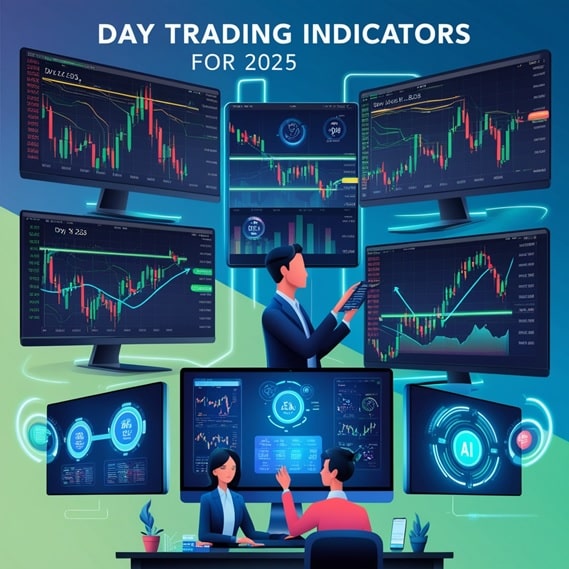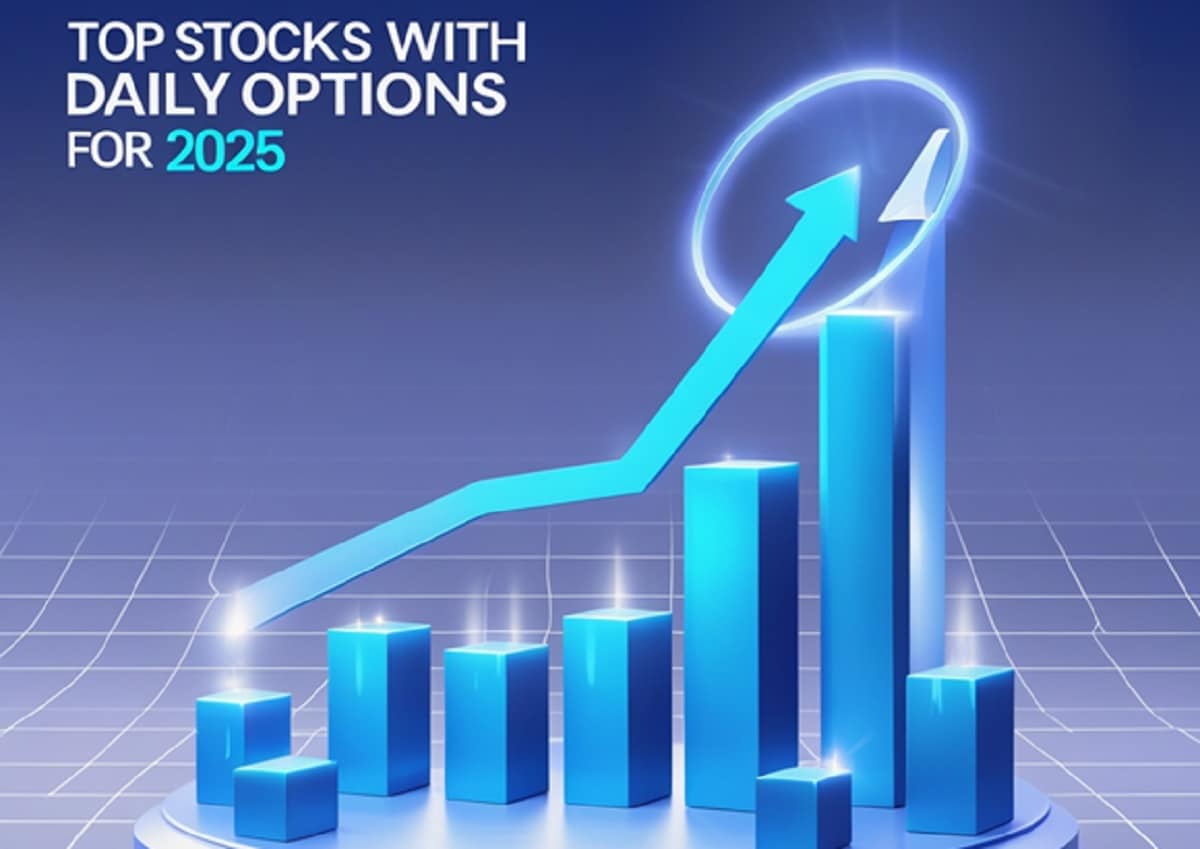Looking to make successful trades in 2025? Check out the most accurate day trading indicators that can guide your choices and help you succeed in trading.
Introduction
In day trading, the market changes constantly, so traders have to react quickly to any developments. Even so, traders cannot always make reliable trades if they lack solid tools. For this reason, traders rely on day trading indicators to identify trading trends, predict the market’s movements and keep from making expensive errors. Since there is an overwhelming amount of indicators, how can you tell which are reliable for 2025? We will cover the most reliable day trading indicators here, explain what they do and guide you on how to achieve successful trades with them.
Understanding Day Trading Indicators
Day trading indicators are designed to assist traders in examining data, noticing trends and deciding rapidly. Price, volume or other data from the market are used in these indicators and the results are displayed as charts. They help a trader decide whether to purchase, sell or keep their assets.
Economists use two categories of indicators: leading indicators and lagging indicators. Leading indicators give an early sign of an expected shift in prices. The Relative Strength Index (RSI) and Stochastic Oscillator are among the examples. On another note, lagging indicators show trends after they start, so they are useful for spotting major trends that are continuing. For example, you could analyze Moving Averages or MACD (Moving Average Convergence Divergence). Knowing how the indicators function and when to apply them will help you succeed in day trading.
Why Using the Right Indicators is Crucial in Day Trading
As prices in day trading can change rapidly, it’s vital to be informed to avoid losses. If indicators are lacking, traders often let their emotions affect their actions, resulting in errors they must pay for. At this point, day trading indicators are useful because they give traders objective feedback to help select the perfect times for entering or exiting a deal.
Employing the correct indicators makes it easier to spot upward and downward trends as well as price movements. As an example, the Moving Average can reveal the direction of the market, while RSI will show you if an asset is currently overbought or oversold. VWAP (Volume Weighted Average Price) can assist you in determining how strongly prices are moving for the period being analyzed. Optimizing your indicators enables you to minimize risks, spot false signals and deal profits.
Types of Day Trading Indicators You Should Know
You must understand the various types of indicators and what each is good for to succeed in day trading. Here are the main kinds of day trading indicators that every trader ought to learn about:
Trend Indicators
They guide traders in estimating whether the price of cryptocurrencies is increasing (bullish), declining (bearish) or staying the same (trending sideways). Popularly used trend indicators are:
- Moving Averages (MA): Smooth out price data to show the general direction over a period.
- MACD (Moving Average Convergence Divergence): Highlights trend changes and momentum.
Momentum Indicators
By monitoring the rate and magnitude of price movements, momentum indicators help traders identify when the market is overbought or oversold. Here are a few notable examples:
- RSI (Relative Strength Index): Shows whether an asset is overbought (above 70) or oversold (below 30).
- Stochastic Oscillator: Compares a specific closing price to a range of prices over a period.
Volume Indicators
To determine the strength of price fluctuations, these indicators monitor trade volume. A trend is frequently confirmed by high volume. Here are several examples:
- VWAP (Volume Weighted Average Price): Shows the average price weighted by volume, useful for intraday trading.
- On-Balance Volume (OBV): Measures buying and selling pressure based on volume.
Volatility Indicators
By gauging the magnitude of market price swings, volatility indicators assist traders in becoming ready for sudden shifts. Typical indications consist of:
- Bollinger Bands: Two bands around a moving average that expand or contract based on volatility.
- ATR (Average True Range): Shows the average range of price movement over a period.
Support and Resistance Indicators
These indicators assist traders in determining critical price points at which a market reversal or halt is expected. Here are several examples:
- Fibonacci Retracement: Uses mathematical ratios to identify potential support and resistance levels.
- Pivot Points: Calculate potential reversal points based on the previous day’s prices.
You may increase your chances of making good trades by selecting the day trading indicators that best fit your trading style by being aware of these different kinds of indicators.
How to Choose the Best Day Trading Indicators for 2025
Making wise trading judgments in 2025 requires choosing the top day trading indicators. But picking the best solutions might be difficult with so many to choose from. When choosing indicators for your trading strategy, keep the following important elements in mind:
Match Indicators to Your Trading Style
Your choice of indicators should align with your trading style. For instance:
- Scalpers (those who make quick trades within minutes) benefit from fast-reacting indicators like RSI or Stochastic Oscillator.
- Swing traders (who hold trades for several hours) may prefer trend indicators like Moving Averages or MACD.
Prioritize Proven Indicators
In 2025, pay particular attention to indications that have proven to be dependable in various market circumstances. Because they constantly produce helpful indications, indicators like Bollinger Bands for volatility and VWAP for volume analysis are still in use.
Avoid Indicator Overload
Confusion and contradicting signals result from traders’ tendency to overstuff their charts with indicators. Instead, employ a mix of two to three complementary indications, like:
- MACD + RSI: For trend and momentum analysis.
- VWAP + Bollinger Bands: For volume and volatility insights.
Test and Adjust Your Settings
The default settings for each indicator might not be appropriate for all trading styles. For instance, you may fine-tune the RSI overbought/oversold levels (from 70/30 to 80/20) or change the duration of a Moving Average (from 50 to 20) for speedier alerts. Test your indicators frequently on a demo account to observe their performance.
Focus on Real-Time Accuracy
Given the rapidity of day trading, your indicators should deliver information instantly. Give top priority to indicators that are simple to use on your trading platform and perform effectively with real-time price data.
You may make sure that your day trading indicators assist you in making precise and successful selections in 2025 by carefully selecting indicators that fit your trading style, staying away from overly complicated settings, and verifying your settings frequently.
Top Day Trading Indicators for 2025: Expert Recommendations
In 2025, some day trading indicators have shown themselves to be dependable and successful for traders trying to increase their profits. The best indicators for day trading this year, according to experts, are as follows:
MACD (Moving Average Convergence Divergence)
- Purpose: Identifies trend changes and measures momentum.
- Why It’s Effective: MACD’s two moving averages (MACD line and Signal line) provide clear buy or sell signals when they cross. This helps traders spot trend reversals early.
RSI (Relative Strength Index)
- Purpose: Measures momentum by identifying overbought or oversold conditions.
- Why It’s Effective: RSI ranges from 0 to 100, with levels above 70 indicating overbought conditions (a potential sell signal) and levels below 30 indicating oversold conditions (a potential buy signal).
VWAP (Volume Weighted Average Price)
- Purpose: Provides the average price of an asset weighted by volume, making it perfect for intraday analysis.
- Why It’s Effective: When making entry and exit decisions, day traders use VWAP to ascertain whether an asset is trading at a fair value (above or below VWAP).
Bollinger Bands
- Purpose: Measures market volatility and identifies potential price reversals.
- Why It’s Effective: The upper and lower bands expand or contract based on market volatility. When the price touches the bands, it often signals a potential reversal.
Stochastic Oscillator
- Purpose: Compares the closing price of an asset to its price range over a specific period.
- Why It’s Effective: It is highly sensitive to price movements, making it ideal for detecting quick reversals in fast-moving markets.
Fibonacci Retracement
- Purpose: Identifies potential support and resistance levels using mathematical ratios (23.6%, 38.2%, 50%, 61.8%, and 78.6%).
- Why It’s Effective: Traders use these levels to identify entry and exit points in trending markets.
ATR (Average True Range)
- Purpose: Measures market volatility.
- Why It’s Effective: A high ATR value indicates a volatile market, while a low ATR value suggests a stable one. This helps traders set accurate stop-loss levels.
You can improve your ability to spot profitable opportunities, steer clear of false signals, and make accurate trading decisions by concentrating on these top day trading indicators for 2025. Your success as a day trader may depend on your ability to comprehend how each of these tools functions and how to combine them.
Combining Multiple Indicators for Better Results
It can be dangerous to rely solely on one day trading indicator since it might give false signals, which could result in poor decisions. To gain a better understanding of market conditions, successful traders frequently combine several indicators. Using indicators that enhance one another rather than ones that offer redundant information is crucial.
Understanding Indicator Confirmation
Using two or more indicators to verify a possible trade signal is known as indicator confirmation. For instance, it might be wiser to wait for additional confirmation before making a trade if the MACD is still displaying an upward trend but the RSI indicates an overbought condition (a sell signal).
Best Indicator Combinations for Day Trading
- MACD + RSI: A potent mix for momentum and trend analysis. Whereas RSI indicates overbought or oversold conditions, MACD displays the trend direction.
- VWAP + Bollinger Bands: For intraday trading, this configuration is effective. Bollinger Bands display volatility and possible price reversals, while VWAP aids in understanding the average trading price.
- Moving Averages (SMA and EMA): You can identify trend shifts and support/resistance levels by combining a short-term EMA (such as 9 or 20) with a longer-term SMA (such as 50 or 200).
Avoiding Indicator Overload
It can be tempting to use as many indicators as you can, but doing so may result in confusing and contradicting signals. Rather, concentrate on two to three indicators that offer various kinds of information:
- A trend indicator (like MACD or Moving Averages).
- A momentum indicator (like RSI or Stochastic).
- A volume or volatility indicator (like VWAP or Bollinger Bands).
Adjusting Indicator Settings for Better Accuracy
The default settings of many indicators might not be appropriate for your trading style. For example:
- For faster signals, change the RSI period from 14 to 7.
- Depending on your trading timeframe, adjust the Moving Average period (e.g., 9 for fast, 50 for medium, and 200 for long-term).
- Reduce the standard deviation to fine-tune Bollinger Bands to increase sensitivity.
Practical Example: Combining Indicators in Action
Consider that the RSI is getting close to overbought levels while the stock you are trading is displaying a strong uptrend (MACD is bullish). To determine whether the price is still higher than the average trading price, you use VWAP rather than selling right away. If it is, you might choose to stay in your current position in the hopes that the trend will continue.
You can improve your understanding of market conditions, steer clear of false signals, and raise your chances of winning trades by combining several day trading indicators.
Mistakes to Avoid When Using Day Trading Indicators
If you use day trading indicators properly, they can greatly improve your trading performance. Regretfully, a lot of traders, particularly novices, make typical errors that result in bad choices and losses. You can avoid costly mistakes by being aware of these mistakes.
Overloading Your Chart with Indicators
Using too many indicators at once is one of the most frequent errors, which results in a cluttered chart with contradicting signals. For instance, combining RSI, Stochastic, and MACD can be confusing because they may produce signals that are in conflict with one another. Limiting your setup to two or three complementary indicators is the answer.
Ignoring Market Context
When used in the appropriate market conditions, indicators perform at their best. For example, moving averages and other trend indicators work well in markets that are trending but not so well in markets that are sideways (ranging). In a similar vein, volatility indicators such as Bollinger Bands can be misleading in stable markets but are helpful in times of high volatility. Prior to relying on indicators, always conduct a market type analysis.
Relying Solely on Indicators
Indicators are instruments, not assurances. False confidence may result from relying solely on them without knowledge of technical analysis, news events, or market fundamentals. For example, if a significant economic report is about to be released, a bullish MACD signal may be deceptive.
Using Default Settings Without Testing
The default settings for the majority of indicators (such as the RSI set to 14 periods) might not be appropriate for your trading style. Performance issues may arise if these settings are not changed. For instance, a 9-period Moving Average offers more pertinent signals for quick trades, whereas a 50-period Moving Average is too slow for day trading.
Ignoring Risk Management
No indicator can ensure complete success. Risk management is essential because even the best setups can go wrong. Establish your risk-reward ratio, set stop-loss levels, and never take on more risk than you can bear.
Chasing Signals without a Plan
A common mistake made by traders is to enter trades immediately after an indicator flashes a signal. Losses could result, for instance, from purchasing as soon as the RSI crosses below 30 without first verifying a reversal. Having a trading plan that outlines your use of indicators, including when to enter and exit, is a better strategy.
Not Backtesting Your Indicator Strategy
Any indicator must be tested in a demo account or backtested using historical data before being used in a live account. This boosts your confidence and enables you to comprehend how it functions in various market conditions.
You can greatly increase your chances of success and steer clear of the pitfalls that many traders encounter by avoiding these typical errors and using day trading indicators with a well-defined strategy.
Future Trends and Innovations in Day Trading Indicators for 2025
The tools that traders use, such as day trading indicators, change along with technology. A number of fascinating developments and trends are expected to revolutionize market analysis and decision-making for traders by 2025.
Integration of Artificial Intelligence (AI) and Machine Learning
Indicators driven by AI are growing increasingly complex, with the capacity to instantly analyze vast volumes of data and identify intricate patterns that are beyond human comprehension. By adjusting to shifting market conditions, these intelligent indicators can increase accuracy and decrease false signals.
Increased Use of Sentiment Analysis
Sentiment analysis from news, social media, and other sources will be incorporated into future day trading tools to measure market sentiment. Traders can predict price movements influenced by crowd psychology by combining sentiment data with conventional technical indicators.
Advanced Visualization and Customization
More interactive and adaptable charting tools are becoming available on trading platforms. Better alignment with their individual strategies will be possible for traders thanks to the increased precision with which they can modify or create custom indicators.
Real-Time Big Data Analytics
Day trading indicators will use big data analytics more and more to offer deeper market insights as processing power increases. As a result, signals based on volume flows, macroeconomic indicators, and even more general market trends will be quicker and more accurate.
Multi-Asset and Cross-Market Indicators
Indicators that examine several assets at once (stocks, forex, and cryptocurrency) will become more and more common as markets grow more interconnected. Traders can more successfully find correlations and hedging opportunities with the aid of this cross-market analysis.
Enhanced Mobile Trading Tools
As mobile trading gains popularity, indicators designed for smartphone and tablet use will become more accessible and user-friendly, enabling traders to make well-informed decisions while on the go without compromising analytical depth.
Integration with Automated Trading Systems
Automated trading bots and algorithms will increasingly incorporate day trading indicators to enable faster execution and the ability to take advantage of transient opportunities without human delay.
By adopting these upcoming developments in day trading indicators, traders will have state-of-the-art resources to handle the volatile markets of 2025. In addition to increasing trading accuracy, keeping up with these trends will give you a competitive advantage in a market that is always changing.
How to Choose the Right Day Trading Indicators for Your Style
The key to success is choosing the best day trading indicators that fit your unique trading style. Knowing your strategy and objectives will help you make wise decisions because not every indicator is appropriate for every trader.
Identify Your Trading Style
- Scalpers: Favor trades with very short durations (seconds to minutes). For prompt entry and exit signals, they require fast-reacting indicators such as short-period EMAs or the stochastic oscillator.
- Momentum Traders: Focus on stocks with strong trends. Indicators like MACD and RSI help identify trend strength and momentum shifts.
- Swing Traders: Hold positions for several days. They often use longer-period moving averages and Fibonacci retracements to identify potential reversal points.
Consider Your Risk Tolerance
Early warning indicators, such as the ATR for volatility, can assist you in avoiding high-risk trades if you are risk averse. Faster indicators that generate more frequent signals—even if some of them are false—may be relied upon by more aggressive traders.
Match Indicators to Market Conditions
Different indicators perform better in specific market conditions:
- Trending markets: Moving averages, MACD
- Range-bound markets: RSI, Stochastic Oscillator
- Volatile markets: Bollinger Bands, ATR
Understanding when to switch indicators based on market behavior is a key skill.
Test and Adjust
Test your selected indicators on a demo account or through backtesting before investing real money. Modify their parameters to better fit your desired asset and timeframe.
Keep It Simple
If necessary, progressively add more indicators after starting with a small number of trustworthy ones. Making your plan too complicated can result in misunderstandings and errors.
You can trade more confidently and consistently and increase your chances of making money by carefully selecting day trading indicators that suit your trading style.
Tips for Mastering Day Trading Indicators and Enhancing Your Trading Skills
It takes discipline, practice, and ongoing education to become proficient with day trading indicators. The following crucial advice will help you improve your trading abilities and get the most out of your indicators:
Educate Yourself Continuously
Indicators and strategies change along with the markets. To improve your knowledge of technical analysis and new developments in indicators, stay current by reading books, enrolling in classes, and keeping up with professional traders.
Practice with a Demo Account
To test the performance of various day trading indicators under different market conditions without having to risk real money, use a demo trading account. Gaining practical experience is crucial for enhancing your confidence and honing your strategy.
Develop a Trading Plan
Make a detailed plan that outlines your entry and exit criteria based on indicator signals, risk mitigation techniques, and your daily objectives. Emotional trading and rash decisions can be avoided by following a plan.
Keep a Trading Journal
Keep a record of each trade, noting the indicators you used, the reason you entered or left, and the result. Regular journal review aids in determining what works and what doesn’t, resulting in ongoing development.
Manage Risk Effectively
Not even the best day trading indicators are infallible. To safeguard your capital, always use stop-loss orders and establish a maximum loss per trade. The secret to long-term success is risk management.
Stay Patient and Disciplined
Before you trade, wait for your indicators to give you strong, verified signals. Refrain from following the market or making trades out of greed or fear.
Adapt to Market Changes
Be adaptable and prepared to modify your indicators or tactics in response to shifts in market volume, volatility, and trends. Tomorrow, what works today might need to be adjusted.
You will improve your proficiency with day trading indicators and your capacity to make more informed, lucrative trading decisions if you adhere to these suggestions and practice regularly.
Conclusion
Knowing how to use the best day trading indicators can mean the difference between steady profits and expensive errors in today’s volatile markets. Even though no single indicator can ensure success, traders can make better decisions by being aware of each one’s advantages, disadvantages, and best ways to combine them.
Using trustworthy tools, choosing indicators that fit your trading style, and keeping up with emerging trends can all greatly improve your day trading experience, regardless of your level of experience. Never forget that indicators are not crystal balls; rather, they are instruments to help you with your strategy. To realize their full potential in 2025 and beyond, approach them with discipline, ongoing education, and reasonable expectations.




































